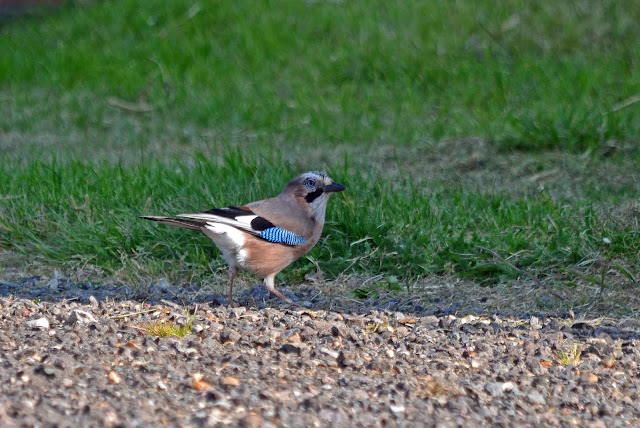Time: from 7:15 a.m.
Weather: dry, sunny, light wind, 11°C to 19°C
This was another early morning visit and it was already very warm.
It proved to be a very productive visit with 24 bird species, 3 mammal species and 2 butterfly species recorded, including 3 new records for the site for me.
The first new site record was a Kestrel which was perched up on the spire of St. Nicholas Church before being seen off by a Magpie.
The second new site record was a fly-over Cormorant.
The third new site record was Holly Blue and I saw 2 of these spring-flying bright blue (when the wings are open) butterflies. These butterflies always remind me of my Mum who sadly died in September 2018. The communal garden to the flats where she lived in Norwich always seemed to have Holly Blues in early May.
There were several other highlights from my visit.
Whilst I had already seen my first Swifts of the year from my flat, I saw my first for this site today. I initially saw 2 in their flickering flight high above St. Nicholas Church but a few minutes later I saw 3 in their typical rapid “screaming” flight much lower and again around the church.
Since I have been visiting this site, I have seen Swifts on an almost annual basis and it is likely that they used to nest in the church tower. However, a few years ago, there was a major refurbishment undertaken to the church tower. St. Nicholas Church was built in the 13th century. The chancel and south aisle were added in the 14th century. The timber roof is more than 500 years old whilst the oldest part is the nave which dates back over 800 years. Obviously as a Grade 1 listed building, its preservation and conservation are very important but since the refurbishment work was completed, I have seen very few Swifts each summer. Surely whoever was responsible for commissioning the work could have ensured continued access to the nest sites for our local Swifts. Evidently not.
The UK's Swifts are in trouble. It is estimated that their population has deceased by 57% between 1995 and 2017, primarily due to the application of pesticides and habitat destruction which has affected their insect food supply. The modernisation of many buildings has also resulted in the loss of roof nesting sites. More information can be found Swift Conservation.
In addition to the Swifts, I also saw 3 singing Chiffchaffs and heard 4
others, saw a singing Blackcap and heard 8 others and heard a calling Green Woodpecker.
Apart from the Holly Blues, I saw a single Speckled
Wood.
With regard to mammals, I saw 2 Red Foxes
and 1 Reeves' Muntjac in the church graveyard and 2 Grey Squirrels
…. plus a cat unsuccessfully staking a claim to be included on the mammal list 😀.
Species recorded during this visit were as
follows (heard only records in italics):
Swift
Blackcap
Chiffchaff
Blue Tit
Great Tit
Long-tailed Tit
Robin
Dunnock
Wren
Blackbird
Song Thrush
House Sparrow
Goldfinch
Starling
Kestrel
Green Woodpecker
Jay
Magpie
Carrion Crow
Woodpigeon
Collared Dove
Carrion Crow
Herring Gull
Lesser Black-backed Gull
Cormorant
Red Fox
Reeves' Muntjac
Grey Squirrel
Holly Blue
Speckled Wood
Here are some photos from my visit:
Photo: Kestrel
Photo: Reeves' Muntjac
Photo: Holly Blue

Photo: Chiffchaff
Photo: Magpie
Photo: Jay
Photo: Jay
Photo: Woodpigeon
Photo: Woodpigeon
Photo: Collared Dove
Photo: you can glare and "miaow" all you like but you ain't getting on that mammal list 😀
Photo: Bluebells
Photo: Bluebells
Photo: Red Campion
Photo: Bluebells
Photo: Horse Chestnut
Photo: Kestrel
Photo: Reeves' Muntjac
Photo: Holly Blue

Photo: Holly Blue
Photo: Long-tailed Tit
Photo: Jay
Photo: Jay
Photo: Woodpigeon
Photo: Woodpigeon
Photo: Collared Dove
Photo: you can glare and "miaow" all you like but you ain't getting on that mammal list 😀
Photo: Bluebells
Photo: Bluebells
Photo: Red Campion
Photo: Bluebells
Photo: Horse Chestnut





























No comments:
Post a Comment
If you feel like commenting on my blog, you can contact me by completing the comment form below. I will respond to all comments and enquiries and constructive criticism will always be welcomed.